With the Holly Springs National Forest, the Red Clay Hills, and the Gulf Island Seashore as just a few examples of the natural wealth of the Hospitality State, Mississippi is a great place for birding and a great place to live in general. Today we are going to discuss the popular backyard birds of Mississippi and tell you a little about the Avian species which you can encounter and we’ll also give you some useful facts for finding these birds, luring them to your backyard feeder, and more! Let’s talk about the popular backyard birds of Mississippi!
3 Categories – 325 Birds
So many birds, so little time… With more than 325 species in Mississippi there is simply no practical way that we can list them all in the space allotted for this article. That said, we’ve gathered together a sampling of some of the birds you are likely to see and we’re going to divide them up for you like this:
- Year-round Resident birds
- Birds of Spring, Summer, and Early Fall
- Fall and Winter Birds
We’ll give you some useful data about these winged wonders which will include some of their favorite feeder foods and where you should look for them when you are out and about. Let’s start with the long-timers, the year-round resident birds of Mississippi.
Mississippi’s Year-round Resident birds
These birds are available year-round and just waiting to be spotted. Long ago they made the decision that Mississippi was the place to be and they have stayed here happily ever since. See if you can spot one of these permanent residents this year:
- Eastern Bluebird
- Carolina Chickadee
- Red-bellied Woodpecker
- Blue Jay
- Mourning Dove
Eastern Bluebird – Sialia sialis
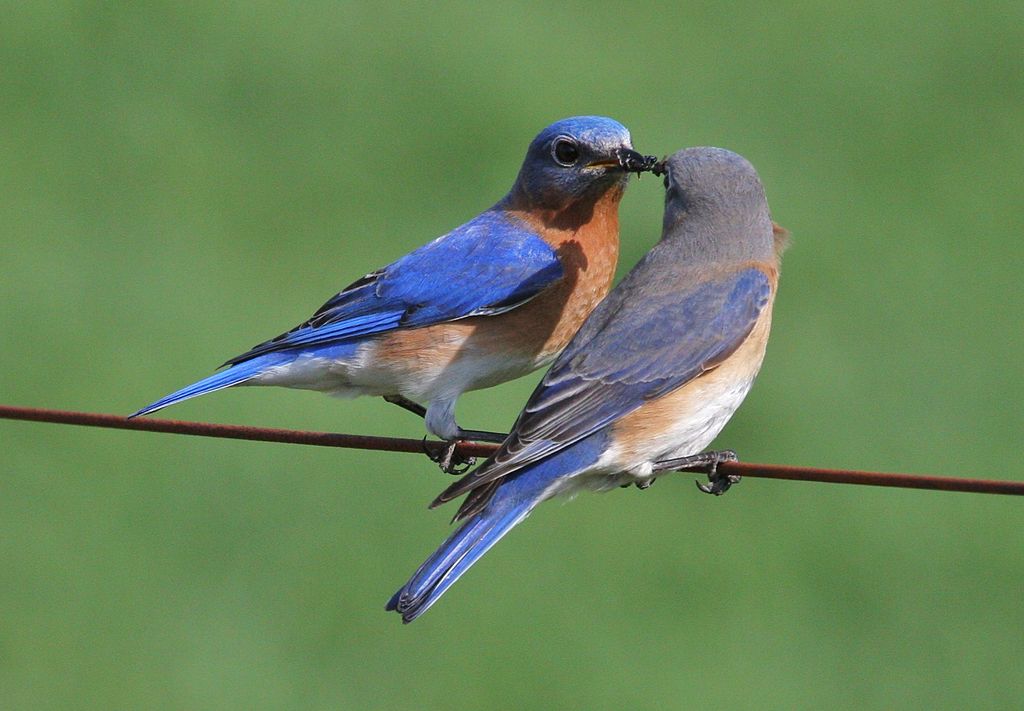
Coloration and Markings: Eastern Bluebirds have backs which are a lovely deep blue, as well as long, blue wings and short, blue tails. They have white rumps and the underbelly and breast of this bird are white as well, but there will be a flanking of orange-red coloration which starts at the underbelly and thickens quite a bit as the color moves into the breast. The look is much the same as if the bird had a red-orange vest. The red-orange color actually goes further up, where it makes a collar, and facially this bird is a striking blue with a short, straight black bill that shows a slight curvature on the upper bill. Females will exhibit a lot of gray on the upper body, though splashes of blue will be present, and the red-orange coloration will be noticeably muted.
Size: These birds measure 6.3 – 8.3 inches in length and have wingspans between 9.8 to 12.6 inches.
Habitat: Eastern Bluebirds prefer open woods so you can spot them sometimes at the forest’s edge, in meadows, or clearings. They do range out, however, and you can see them at golf courses, overgrown fields, or in backyards with well-stocked feeders or prepared birdhouses. That’s right, these birds are receptive to nesting boxes!
Diet: Suet, Black Oil Sunflower seeds, mealworms, and whatever fruit that you have on hand are all good foods to leave in your feeder if you want to attract Bluebirds. They will also eat eggshells, said to help in their digestion, just crush them up a bit and add to your feeder.
Carolina Chickadee – Poecile carolinensis
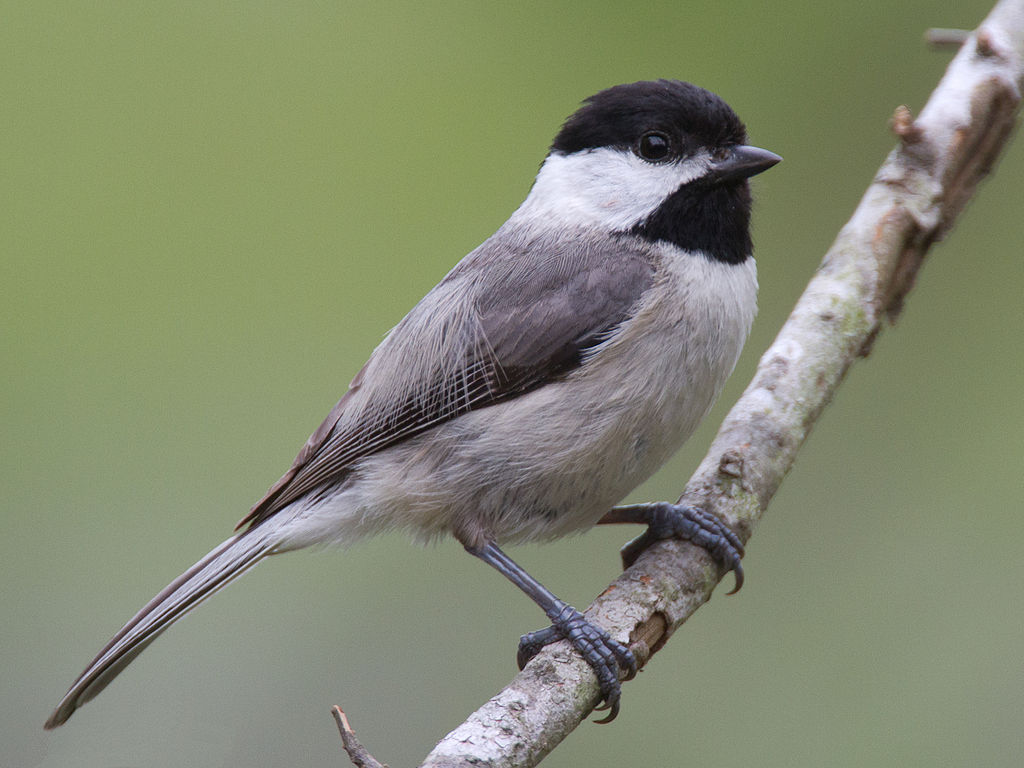
Coloration and Markings: Carolina Chickadees have velvety-soft gray backs, with short wings and long, thin tails of the same color. You will see some white edging in the wings and some white tailfeathers, however, so watch for those too. The underbelly and breast of this bird are white but facially, this bird has a small, black bib and a large, black cap which terminates about mid-eye level with the central color in between cap and bib being white. These birds have tiny, triangular black bills.
Size: This bird measures in at 3.9 – 4.7 inches in length and has a wingspan of 5.9 to 7.9 inches wide.
Habitat: These birds may be found in the woods but they are also frequent visitors of parks and well-stocked backyard feeders.
Diet: These birds eat mostly insects and so your best plan is to leave out some suet for them. It is high-energy food and these birds love it.
Red-bellied Woodpecker – Melanerpes carolinus

Coloration and Markings: Red-bellied Woodpeckers look quite exotic, with their zebra-striped backs and long wings and their short, notched black tails which are white on the undersides. They have a white underbelly and breast but you will see splashes of reddish color as if someone was flicking juice at the bird and if you look close you can see a big, red spot at the underbelly. Facially, this bird has a mostly-white face with splashes of red around the cheeks and a long, red cap that carries down to the nape of the neck. These birds have long, straight black bills.
Size: These birds measure approximately 9.4 inches from tip to tail and have wingspans between 13 and 16.5 inches wide.
Habitat: These birds love older, mature woods and are especially fond of trees such as Hickory and Oak and assorted hardwoods. They venture out quite often when foraging so you can also see them in parks or your own backyard.
Diet: Sliced apples, suet, corn, and a number of other foods will tempt these handsome omnivores. They also like to take a drink or two from Hummingbird feeders so if you don’t have one you might consider getting one to help in luring this Woodpecker a little closer.
Blue Jay – Cyanocitta cristata
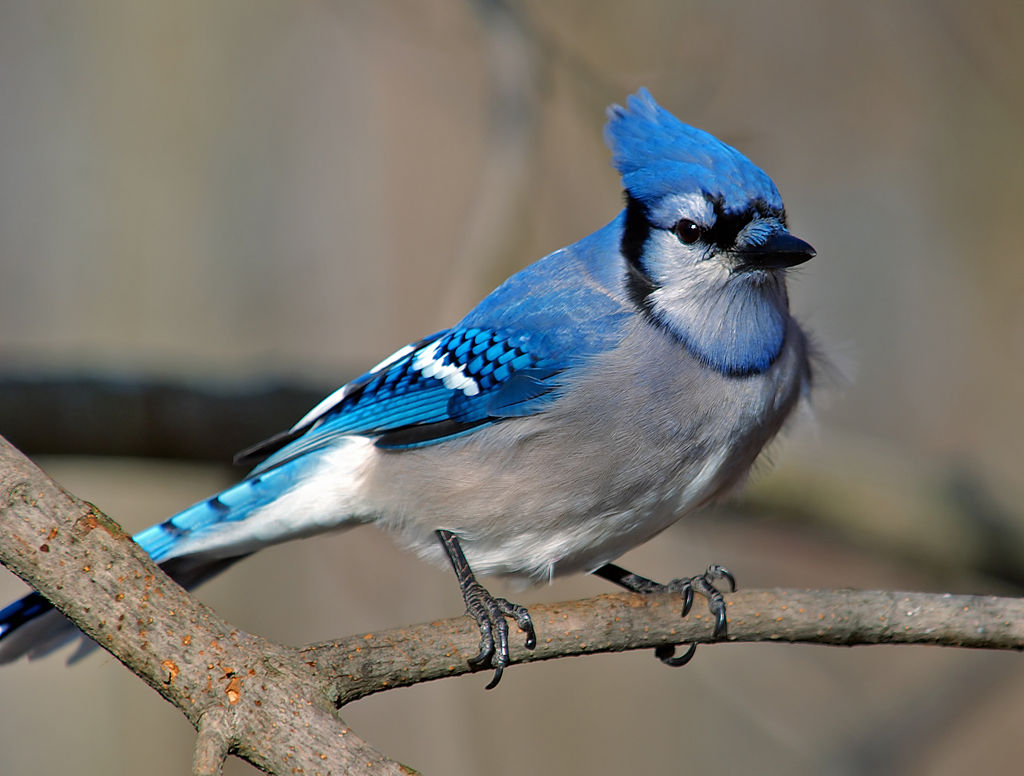
Coloration and Markings: Blue Jays have deep blue backs with medium-length, blue wings, which display a scaling pattern of blue outlined in black just under the shoulder as well as assorted large, white and blocky spots outlined in black. They have long, broad tails with white outer feathers and patterns of small squares made of light blue outlined in darker blue arranged symmetrically down the tail. The underside of the tail will be a snowy white, as is the bird’s rump, underbelly and breast, and facially, there is a division line of black encircling the base of the throat which starts and ends at the back of the bird’s head behind a majestic, light-blue crest. The remained of the face will be the same brilliant white, with the exceptions of a thin, somewhat abstract black mask and a long, straight black bill.
Size: Roughly the same size as a big Robin, these birds measure in at 9.8 – 11.8 inches in length and have wingspans of 13.4 to 16.9 inches in width.
Habitat: These birds love the forest’s edge, especially if there are Oak trees nearby which provide them with some delicious acorns to smash open. They are bold, however, and venture into the city from time to time. Look for them at golf courses, woodlots, and in backyards where feeders have been prepared in anticipation for their arrival.
Diet: Suet, peanut butter, and Black Oil Sunflower seeds are 3, easy-to-provide favorites that can make you a beautiful blue friend.
Mourning Dove – Zenaida macroura
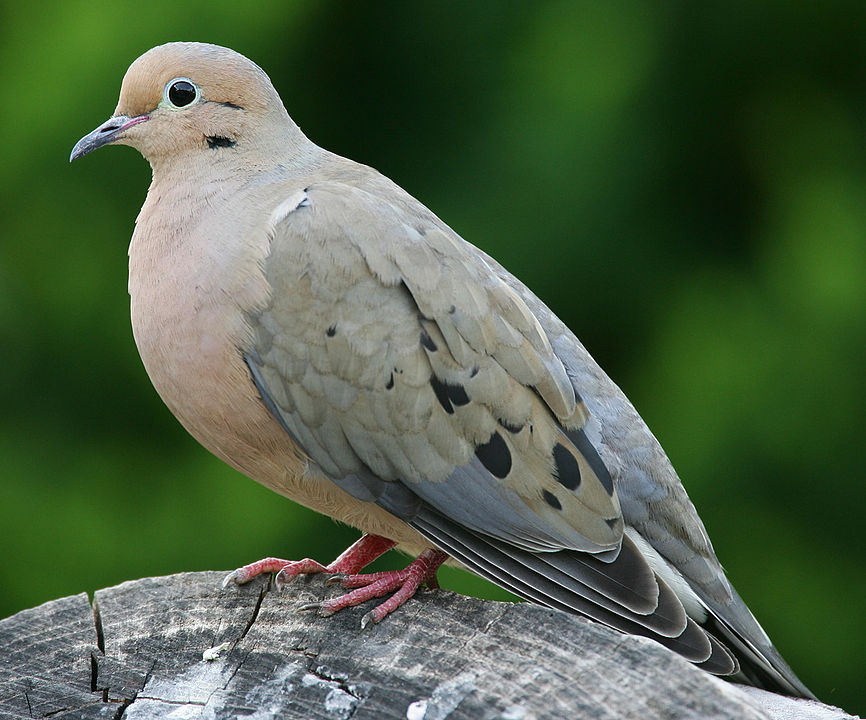
Coloration and Markings: Mourning Doves have gray backs with large, gray wings and long, pointy gray tails which are a quite unique feature among North American Doves. The center of the wings has a concentration of beautiful tan coloration as well as some large, black spots which are quite delightful. These birds have white rumps and a creamy tan coloration at the underbelly and breast, with tiny spots of white at the edges. Facially, the heaviest cream-tan color will be present, and this helps to highlight a lovely white eyering of this bird. This Dove has a medium length, thin, black bill.
Size: These birds measure in at 9.1 – 13.4 inches in length and have wingspans of approximately 17.7 inches in width.
Habitat: These birds don’t even seem to like the woods, preferring farm feedlots and wandering around the city for their foraging. Look for them on phone lines and fences and be sure to leave a little something out for them if you’d like a closer look.
Diet: Peanuts and cracked corn are 2 favorites of the Mourning Dove which you can leave out to attract and possibly keep their attentions.
Mississippi’s Birds of Spring, Summer, and Early Fall
Daffodils start to bloom and if you’ve got a garden then your spring onions and radishes will be popping right up – this means that springtime has arrived in Mississippi. During this time and through the warmer months you may be able to spot one of these lovely birds:
- Indigo Bunting
- White-eyed Vireo
- Chimney Swift
- Black-billed Cuckoo
- Blackburnian Warbler
Indigo Bunting – Passerina cyanea

Coloration and Markings: Male Indigo Buntings are small but stunning. They are completely (or typically almost completely) a vibrant, indigo blue all over their bodies. Their short wings make their short tails look a little longer and you will notice that the tail feathers are rounded at the ends. Silver-grey is also sometimes present at the wingtips, but not always. Facially, these birds have stout, medium-length silver bills. Females will look quite different, having mostly an olive-brown coloration with splashes of blue throughout the plumage as well as heavy olive streaking at the breast. You will also seem some white at the throat and a white mustache line. Juveniles, however, tend to be a mix of brown and blue patches, with the blue winning out slowly over time.
Size: These little birds measure in at 4.7 – 5.1 inches in length and have wingspans of 7.5 to 8.7 inches.
Habitat: Indigo Buntings love brushes, shrubs, brambles, and thorns. Look for them anywhere there is some cover to duck into, be it brushy roadside, rows of hedges, or overgrown, weedy fields.
Diet: Nyjer seed and Blueberries are a simple combination that these birds love. Give it a try and see for yourself!
White-eyed Vireo – Vireo griseus

Coloration and Markings: White-eyed Vireos have an olive-yellow cast to their backs and small, grayish wings with touches of yellow throughout and 2 distinct white wingbars on each wing. They have medium-length gray tails with yellow outer feathers and yellow on the undersides as well as a white rump. The underbelly and breast of this bird are white as well, with a heavy flanking of bright yellow coloration and facially, this bird will be mostly off-white or silvery gray in the face, with yellow at the forehead and lightly surrounding the eyes. You will notice eyering ‘spectacle marks’ as if this bird is studying for a test and it also has a small, but stout, straight black bill. A light curvature is readily apparent on the upper bill.
Size: These diminutive beauties measure just 4.3 – 5.1 inches in length and have wingspans of approximately 6.7 inches wide.
Habitat: These bird’s love the forest’s edge but may be found anywhere there is scrub or brush cover. They are fond of water, so be especially aware around riverside scrub or brush areas as these are favorites of the White-eyed Vireo.
Diet: While primarily insectivorous, you can sometimes tempt these birds with a suet feeder and live mealworms are also a good bet for attracting these Vireos.
Chimney Swift – Chaetura pelagica

Coloration and Markings: Chimney Swifts have quite the distinctive look at they fly overhead, resembling nothing more than a flying cigar! They are a mix of dark gray and brown all over their bodies, with long, curved wings and short, tapered tails. Facially, you will notice a small, but wide, lightly-curved black bill.
Size: These birds measure in at 4.7 – 5.9 inches in length and have wingspans of 10.6 to 11.8 inches.
Habitat: Chimneys, air vents, wells, and even caves… Chimney Swifts like to hole-up when they nest and any hollow, even in a tree is fine cover. They are especially fond of areas close to water where the foraging is good but they range out quite often into suburban areas.
Diet: These birds are completely insectivorous, so you won’t be able to lure them to your feeder. They might roost in your chimney, though, if you aren’t using it.
Black-Billed Cuckoo – Coccyzus erythropthalmus

Coloration and Markings: Black-billed Cuckoos have a very simple coloration, with brown on top and white below. They have long, brown wings and very long brown tails, with white tips, as well as white around the edges and light undersides. The underbelly and breast of this bird will be white as well and this white carried up into the face where it terminates at a level equal to the lower bill. Sometimes some tannish color may be seen at the chin as well. The remaining top-half of the head is brown and these birds have a red ring around their eyes as well as a long, slightly curved black bill.
Size: These birds range in at 11 – 12.2 inches from tip to tail and have wingspans of 13.4 to 15.8 inches wide.
Habitat: These birds prefer woods which are a mix of deciduous and evergreen varieties, close to water whenever it is possible. They love the cover of thickets and thorns and while they will venture out into parks, orchards, gardens, and backyards, there will typically be shrub cover nearby.
Diet: These birds will likely not come to a feeder, as they prefer to catch live insects on their own and are especially fond of caterpillars. You might try leaving out some mealworms but results cannot be guaranteed.
Blackburnian Warbler – Setophaga fusca

Coloration and Markings: BlackBurnian Warblers are cute little guys, with the males displaying black backs with short black wings, which have a number of white patches present. They have medium-length black tails which are black with white edging and shite undersides and the underbelly and breast of this bird are white with black streaking at the flanks. Facially, this birds face is is orange, with a triangle of color going down past the throat and into the breast as well as a triangular black, with small, orange crescents underneath the eyes, and a black crown. Females and juveniles will be gray, rather than black, with 2 white wingbars present and yellowish underbellies.
Size: Quite small, these Warblers measure in at 4.3 – 4.7 inches in length and have wingspans of 7.9 to 9.1 inches wide.
Habitat: These birds love coniferous and deciduous-coniferous mixed woods, but you can find them just about anywhere that there are trees. If you have some trees in your backyard or the right foodstuffs present then you might just get a visit!
Diet: While they mostly eat insects, these birds can occasionally be lured to your feeders if you’ve got some suet.
Mississippi’s Fall and Winter Birds
With winter lows around 39 degrees Fahrenheit Mississippi gets a little chilly but winter could certainly be worse. That said, this is a time when your feathered friends need you, so be sure to leave out some invigorating snacks for chilled feathered friends like these Mississippi winter birds:
- American Robin
- Eastern Phoebe
- American Goldfinch
- Lapland Longspur
- Horned Lark
American Robin – Turdus migratorius
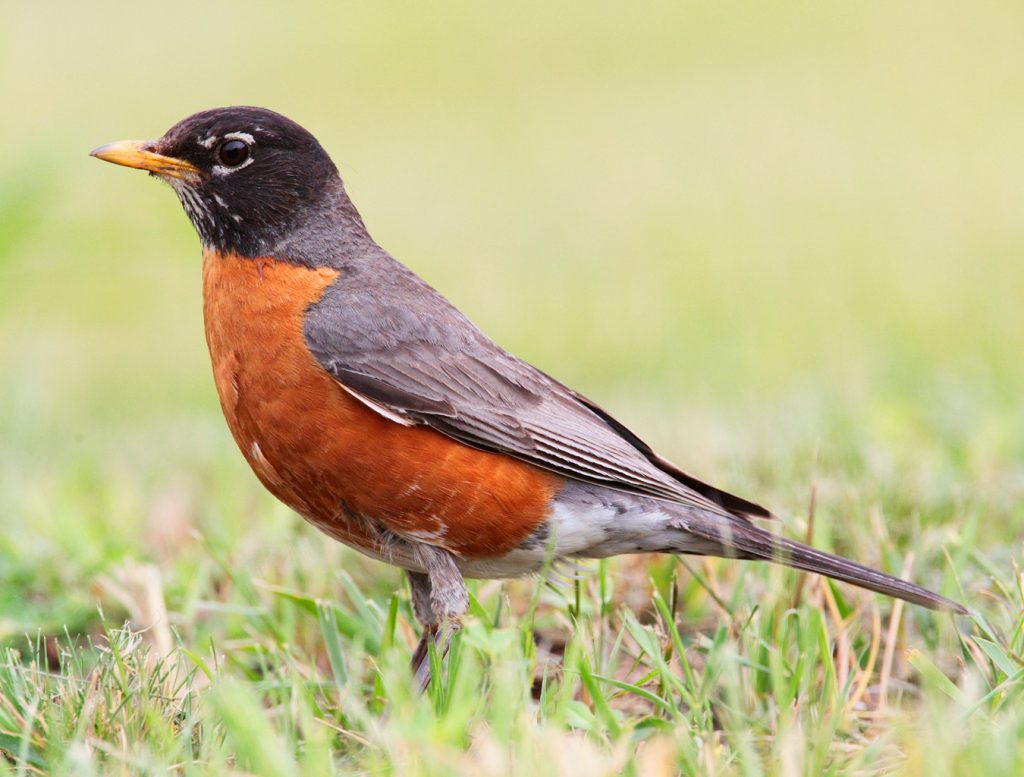
Coloration and Markings: American Robins have grayis-brown backs with medium-length wings of the same color and long, grayish-brown tails with white edging and white on the undersides coming from the bird’s white rump. The underbelly and breast of this bird are a reddish-orange color and facially, these birds have black heads. The black is unbroken except for a ‘shattered’ eyering encircling each eye and a medium-length, curved yellow bill that often has a touch of black at the tip. Females will have the same color scheme but the colors will be much less bold, almost seeming to run together due to lesser contrast.
Size: These birds measure in at 7.9 – 11 inches in length and have wingspans of 12.2 to 15.8 inches.
Habitat: You can see them in snowy pine forests or deciduous woods but these birds are quite urbanized as well, venturing out into gardens, orchards, and even golf courses. They like well-stocked backyard feeders so be sure to put a little something out and you might get a visiting Robin.
Diet: Raisins, crushed nuts, or good ol’ suet, these birds are easy to please.
Eastern Phoebe – Sayornis phoebe

Coloration and Markings: Eastern Phoebes have grayish-brown backs with long, grayish-brown wings which display some minute white edging. They have perky, medium length gray tails and the underbelly and breast of this bird are a fluffy white. This white carries up to the base of the throat, moving back over the shoulders before thinning out completely at the back of the head. Facially, this bird has a white chin and the lower half of the face starting at about mid-bill level is usually a lighter gray than the darker gray taking up the rest of the face above it. These birds have thin, straight, and medium-length black bills. In the fall you might seem some yellowish color at the belly as well.
Size: These birds measure in at 5.5 – 6.7 inches in length and have wingspans of 10.2 to 11 inches in width.
Habitat: These birds love the forest’s edge and open areas such as meadows, clearings, and copses. They are fond of the city as well, though, and often nest in bridges and buildings.
Diet: Suet cakes and mealworms, either dried or live, are your best bet when it comes to enticing the Eastern Phoebe into visiting your backyard feeders.
American Goldfinch – Spinus tristis

Coloration and Markings: Male American Goldfinches are bright and easy to recognize. They have bright yellow backs with long, black wings which display 2 wingbars on each wing as well as assorted vertical white marks towards the center-top of the wings. They have short, notched black tails with white markings as well and white on the undersides coming from the rump. The underbelly and breast of this bird are bright yellow, as is the bird’s face with the exception of the birds small black cap at the forehead and a medium-length, conical orange bill. Females will have olive coloration instead of the black and somewhat dimmer yellows and in winter, both birds will be brown with dim, but distinctive white wingbars still present.
Size: These little birds measure in at 4.3 – 5.1 inches in length and have wingspans of 7.5 to 8.7 inches.
Habitat: These birds like overgrown, weedy fields, especially in areas which are prone to flooding and thus excellent for foraging. They range out often, bold birds that they are, and may also be seen at roadsides, gardens, orchards, and backyards.
Diet: American Goldfinches love suet and peanut butter, why not try missing the 2 up together? It’s an easy treat to make and these little birds love it.
Lapland Longspur – Calcarius lapponicus

Coloration and Markings: Male Lapland Longspurs have somewhat mottled, brown streaked backs, with long wings which have black, mottled streaking towards the top with the majority of the rest of the wings being brown with some grays thrown in. as well as white edging and highlights. They have short tails which will have the same coloration on top but will have white edges and white undersides. The underbelly and breast of this bird are white with a small amount of black streaking present at the sides and facially, this bird has a black chin and cheeks as well as a large, irregular shaped bib as well as a small, black crown at the top of the head. The remaining portions of the face will be white with the exception of a rusty-red mark at the back of the neck. This bird has a short but stout conical bill which is yellow or brown in color. Females will lack the black color and tend to be more of a mix of olives and tans. During the cold months, these birds have more streaking on their plumage, as well as similar patterning, but they will molt away most of their color.
Size: These birds measure in at 5.9 – 6.3 inches in length and have wingspans of 8.7 to 11.4 inches.
Habitat: These birds are at home in open, snowy areas, and are commonly spotted in fields, at the coast, or even in farms.
Diet: Black Oil Sunflower seeds and Nyjer thistle are both excellent additions you can add to a ground feeder for a Lapland Longspur. Be sure to sprinkle some seeds at the base, however, to help to get this birds attention.
Horned Lark – Eremophila alpestris

Coloration and Markings: Horned Larks are generally gray or a sandy-tan color on their backs as well as their medium-length wings and medium-length tails. The underbelly and breast of this bird will be off-white or white with a heavy flanking or the gray or sandy-tan color which increases in thickness going up from the underbelly to the breast. The throat and the face of this bird will typically be a snowy white or yellowish color with a black mask which dips down widely onto the cheek once it leaves the back of the eyes. The top and back of the bird’s head will be brown but you will see a black ‘circlet’ line which terminates at the top and back of the head and raises mini-tufts to create the bird’s ‘horns’. This bird has a straight, thin black bill which sometimes has a little white on the lower bill and displays a slight curve on the upper. Females will be marked similarly but have much more muted coloration.
Size: These birds measure in at 6.3 – 7.9 inches in length and have wingspans of 11.8 to 13.4 inches wide.
Habitat: These birds love open patches of ground where grass is short, patchy, or even missing. You can see them foraging in the snow or desert scrub or sometimes even in lawns with short, trimmed grass.
Diet: Just put out some Black Oil Sunflower seeds and you’ve got all that you need to tempt the Horned Lark. Just be sure to use a ground level feeder and sprinkle some seeds around the base.
Supporting cast (Other Backyard Birds of Mississippi that might pay you a visit)
Just to help to make sure that you’ve got a good year-round checklist we’re including some birds from our ‘Supporting cast’. These birds are all around you, year-round, and they are also quite beautiful and more than happy to see what you’ve got in that feeder. See if you can spot one of these ‘Supporting cast’ birds:
- Eastern Towhee
- Northern Cardinal
- Tufted Titmouse
- Northern Mockingbird
- Downy Woodpecker
Eastern Towhee – Pipilo erythrophthalmus

Coloration and Markings: Male Eastern Towhees have black backs with medium-length black wings, where you will you will see a few white patches. They have long, black tails which display some white on the outer edges as well. The rump of this bird is a reddish orange and the underbelly and breast are white with a flanking of reddish orange, which is thickest at the breast. Facially, this bird is completely black and the coloration goes down past the throat and v’s at the top of the breast. A very small black crest may sometimes be seen and you will notice the bird’s red eyes as well. Towhees have stout, medium-length, conical black bills. Female Eastern Towhees will look much the same, though the black will be replaced with a dark and lighter mix of browns.
Size: These birds measure in at 6.8 – 8.2 inches from tip to tail and have wingspans of 7.9 to 11 inches in width.
Habitat: These birds love the forest’s edge and anywhere that there is a little foraging cover, be it something as simple as a leaf pile or something better like shrubs, hedgerows, thickets, brambles, and thorns. This type of vegetation makes the birds feel safer when they forage so keep an eye out when you see brush cover.
Diet: Suet, rolled oats, and raisins are an easy lure to provide that might just get the attentions of a local Eastern Towhee.
Northern Cardinal – Cardinalis cardinalis
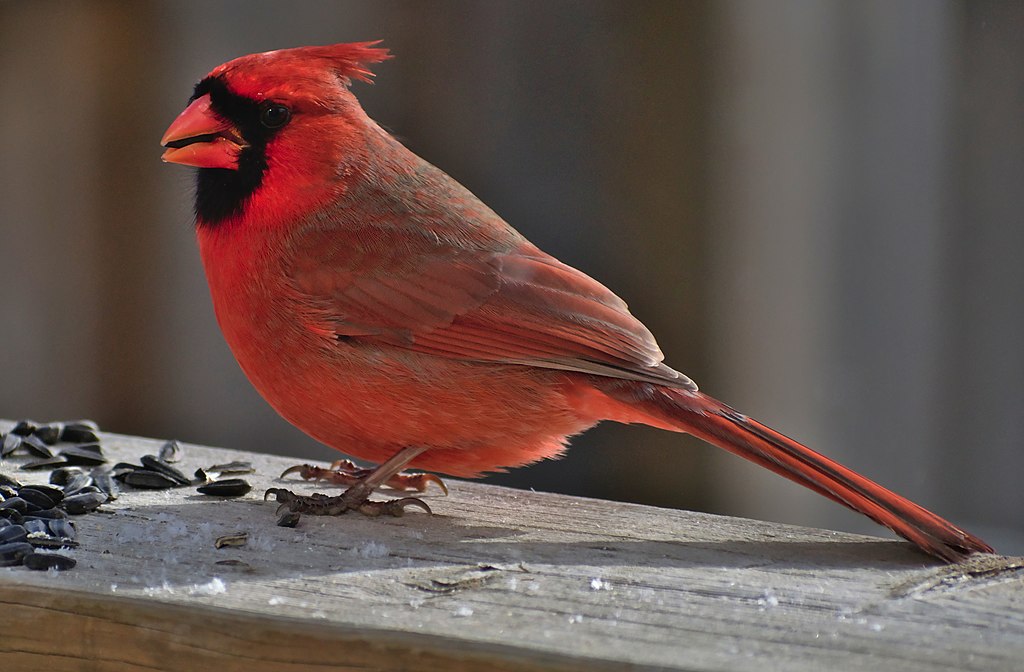
Coloration and Markings: Male Northern Cardinals are completely red with just a few exceptions and the look is nothing short of stunning. They have medium-length red wings and long, red tails, and though you might see some gray from time to time this is simply a sign that the bird is molting. Facially, they have a distinctive black mask that covers the eyes and goes down into the chin as well, where it displays like a little black goatee, and these birds have short, stout, and conical, orange-red bills. Finally, this bird has a beautiful red crest that you just can’t miss. Females will be recognizably Cardinals but they will be a warm brown color, with some touches of red throughout the plumage.
Size: Cardinals measure in at 8.3 – 9.1 inches long and have wingspans of 9.8 to 12.2 inches wide.
Habitat: These birds like the forest’s edge, especially if there is some shrub cover, but they are also seen quite often in woodlots, parks, and backyards with well-stocked feeders.
Diet: Black Oil Sunflower seeds, wheat, rolled oats, and whatever fruits you have handy are great choices for luring a Northern Cardinal into your backyard for a closer look.
Tufted Titmouse – Baeolophus bicolor
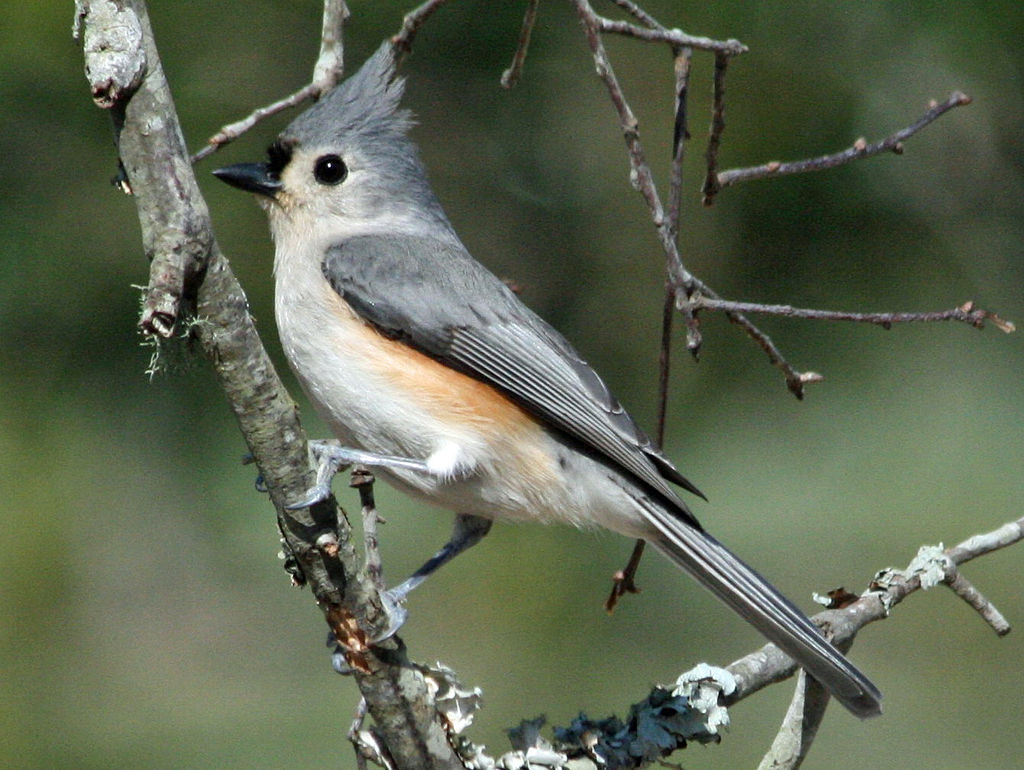
Coloration and Markings: The Tufted Titmouse has a bluish-gray back with small wings and a long tail of the same color. The underbelly and breast of this bird are white, but you will also notice a faint peach coloration at the sides. Facially, these birds have white faces, except for their blue crest and some color which comes down from it at the back of the head to split, with part around the back of the eye and the rest going down to the base of the neck. They also have a square black mark above a shot, but thick triangular black bill.
Size: These birds measure in at 5.5 – 6.3 inches in length and have wingspans of 7.9 to 10.2 inches.
Habitat: Tufted Titmice may be found in Evergreen and deciduous mixed woods but they range quite often, visiting parks, gardens, orchards, and backyard feeders.
Diet: These birds like crunchy peanut butter and suet but for best results, add some Black Oil Sunflower seeds to the peanut butter or in a separate feeder.
Northern Mockingbird – Mimus polyglottos

Coloration and Markings: Northern Mockingbirds have brownish-gray backs with short, brownish-gray wings which display 2 white wingbars as well as 1 large white patch, the latter only being visible when the bird is in flight. They have long, perky tails which are gray with white edging and facially, they have white chins and a patch of white at the cheeks with the top and back of the head being a soft gray or brown-gray. These birds have medium-length, straight black bills with a slight curve present in the upper bill.
Size: Mockingbirds measure in at 8.3 – 10.2 inches in length and have wingspans of 12.2 to 13.8 inches wide.
Habitat: These birds prefer open areas, such as the forest’s edge, meadows, and fields, but they are also quite urbanized. You can find them in trees around the city and they are frequent visitors to backyard feeders.
Diet: Sliced apples or oranges are a cheap and effective lure for getting a Mockingbird’s attention.
Downy Woodpecker – Picoides pubescens
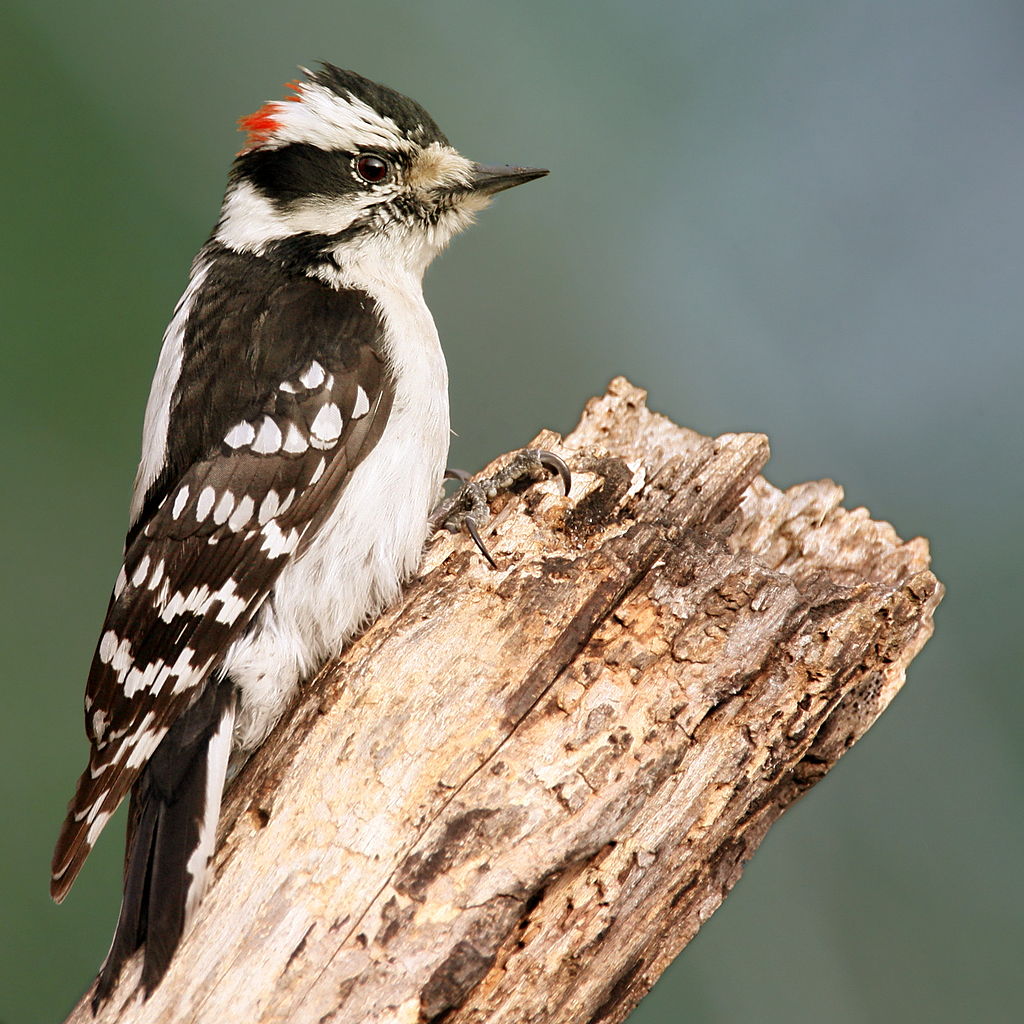
Coloration and Markings: Downy Woodpeckers have a black line between the shoulders and a broad, white stripe across the center of the back. They have long, black wings which display a striping pattern a bit below the shoulder and the stripes are made of blocky white spots. This gives them a bit of a checkboard effect. They have stiff, notched black tails which are white on the undersides and the underbelly and breast of this bird are a paper-white. Facially, these birds have white faces with the exception of a black mustache line, a ‘bandit’ mask that terminates at the back of the head, and a black cap that terminates at the end of the mask. A red dot will be present just above the mask if you are viewing a male but with females the cap will be a solid black. These birds have thin, black, almost tubular bills of medium length.
Size: These tiny Woodpeckers measure in at 5.5 – 6.7 inches in length and have wingspans of 9.8 to 11.8 inches. This makes them the smallest species of North American Woodpecker.
Habitat: These birds prefer open, deciduous woods where they like to be close to dense brush, scrub, or shrubs. They are bold little birds, venturing out often where you can spot them in parks, orchards, and backyards.
Diet: Suet, peanuts, and cracked corn are all favorites of the Downy, who will probably wash them down with some sips of sugar water from your Hummingbird feeder. These little guys and gals have a sweet tooth.
Mississippi Bird Buffet
When you want to find that perfect feeder combination for attracting a diverse collection of birds to your backyard it’s always good to get a little advice from folks in the know. Today we’ll be sharing some of our own recommendations as well as some from the Mississippi State University Extension in regards to choosing the right feeder foods. They go into more detail and you can view their full article by using our reference link at the end of this article. In the meantime, try experimenting with some of these foods in your feeders:
- Black Oil Sunflower seeds (pure, not mixed, as filler material can attract rodents)
- Safflower Seeds
- Nyjer thistle
- Crunchy peanut butter
- Grape jelly
Mississippi Birding Hot Spots
While it is nice when birds visit your backyard, sometime it’s also fun to visit their backyards so that you can get a glimpse or maybe even a photo of your favorite feathered friends in their native habitats. So, when you have some time, try one of these locations or even use our reference link and see what is close to you. Then you can get fresh photos of Avian celebrities like a real Chirparazzo.
- Northern hotspot – South Campus Rail Trail
- Eastern hotspot – Columbus Riverwalk
- Southern hotspot – Tuxachanie National Recreation Trail
- Western hotspot – Hollandale Rail-Trail
- Central hotspot – Spillway Road Multi-Use Trail
Detailed descriptions of each location as well as information regarding visiting and what birds you can see at these locations may be found at https://www.traillink.com/stateactivity/ms-birding-trails/
In Closing
In this article we have briefly explored the wonderful world of Mississippi birding. With more than 325 birds, you local birders certainly have a big, happy job ahead of you, so color us a little envious. Just to be sure to snap a photo or two when you can to share the love and to show the birders in the other states what they are missing in the lovely state of Mississippi. Until next time, we wish you all happy birding!
